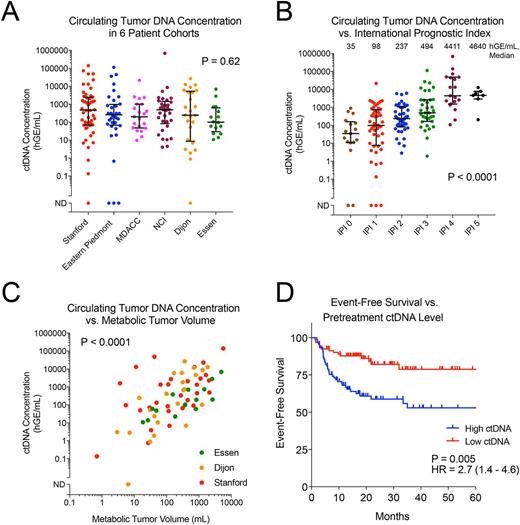Abstract

Background: Pretreatment tumor burden is a known prognostic factor in diffuse large B cell lymphoma (DLBCL). Components of the International Prognostic Index (IPI), including lactate dehydrogenase (LDH) and clinical stage, attempt to capture tumor burden but lack specificity. Tumor volume is an alternative metric for disease burden, but requires specialized radiographic interpretation. We recently described circulating tumor DNA (ctDNA) levels as a novel quantitative biomarker for disease burden in DLBCL (Scherer F and Kurtz DM, Sci Transl Med 2016). To validate the performance of ctDNA across a diverse cohort of patients and medical centers, we assessed pretreatment ctDNA levels in patients with DLBCL from six centers around the world.
Methods: We performed Cancer Personalized Profiling by Deep Sequencing (CAPP-Seq) on pretreatment cell-free and germline DNA from patients undergoing curative-intent anthracycline-based therapy. Somatic mutations were identified and variant allele fractions were determined. Levels of ctDNA were determined using the mean tumor allele fraction and the total concentration of cell-free DNA; absolute concentration of ctDNA was expressed as haploid genome equivalents per mL (hGE/mL). Finally, we correlated levels of ctDNA with clinical factors including stage, IPI, pretreatment metabolic tumor volume (MTV), and patient outcomes.
Results: A total of 183 patients from six centers were enrolled (Stanford University, n=52; University of Eastern Piedmont, n=36; MD Anderson Cancer Center, n=21; Hospital Le Bocage, Dijon, n=25; the National Cancer Institute, n=33; and University Hospital Essen, n=16). Pretreatment cell-free DNA was sequenced deeply; ctDNA was detectable prior to therapy in 97% of patients. The performance of ctDNA detection was consistent across cohorts, with >90% of patients from each center having detectable ctDNA. Concentration of ctDNA was not significantly different across cohorts, with a median of 295 hGE of tumor DNA / mL (one-way ANOVA, P=0.62; Fig 1A). Using pretreatment plasma, all but 5 patients had mutations identifiable via non-invasive genotyping without knowledge of tumor genotype. In 88 patients with tumor samples available, a median of 81% (interquartile range: 34-92%) of variants identified via non-invasive genotyping were confirmed by tumor sequencing on a per-patient basis.
We next sought to correlate levels of ctDNA with independent measures of tumor burden. We found a significant difference in ctDNA levels between patients in different IPI risk groups (one-way ANOVA, P<0.0001; Fig 1B). We also found that patients with higher-stage disease had higher ctDNA levels (P<0.0001); ctDNA levels also correlated with LDH (P<0.0001). We demonstrated a robust correlation between MTV and ctDNA level (P<0.0001; Fig 1C). This correlation was consistent across all three cohorts with MTV available (Essen: P=0.0005, r=0.80; Dijon: P<0.0001, r=0.73; Stanford: P=0.006, r=0.50). Finally, pretreatment ctDNA concentration was continuously associated with EFS and OS (P<0.0001 and P=0.0014). Using the median to divide patients into groups with high or low ctDNA, we found patients with high ctDNA levels had significantly inferior EFS compared to those with low ctDNA (P=0.005, HR 2.7, 95% CI 1.4-4.6; Fig 1D).
Conclusions: Circulating tumor DNA is a robust biomarker of disease burden in DLBCL in patients from multiple medical centers across North America and Europe. Patients from different centers have similar levels of ctDNA despite pre-analytical variation. Concentrations of ctDNA correlate with stage, IPI, and tumor volume; furthermore, ctDNA level prior to therapy is prognostic of clinical outcome. This study validates previous findings and provides evidence that ctDNA is a reliable biomarker in aggressive lymphomas that could be used to refine clinical estimates of disease burden including stage.
Figure 1: Reproducibility and clinical significance of pretreatment ctDNA. A) A stacked scatter plot compares ctDNA levels from patients across 6 cohorts. B) A stacked scatter plot shows ctDNA levels from patients with different IPI risk categories. C) A scatter plot compares metabolic tumor volume to ctDNA level. D) A Kaplan Meier estimate demonstrates event-free survival from the start of therapy for patients with pretreatment ctDNA level above and below the median value. (ND: Not detected).
Hüttmann: Bristol-Myers Squibb, Takeda, Celgene, Roche: Honoraria; Gilead, Amgen: Other: Travel cost. Casasnovas: Roche: Consultancy, Honoraria, Research Funding; BMS: Consultancy, Honoraria; Takeda: Consultancy, Honoraria; Gilead: Consultancy, Honoraria, Research Funding; Sanofi: Consultancy, Honoraria; Abbvie: Consultancy, Honoraria. Westin: Apotex: Membership on an entity's Board of Directors or advisory committees; Novartis Pharmaceuticals Corporation: Membership on an entity's Board of Directors or advisory committees; Celgene: Membership on an entity's Board of Directors or advisory committees; Kite Pharma: Membership on an entity's Board of Directors or advisory committees. Gaidano: Roche: Consultancy, Honoraria; AbbVie: Consultancy, Honoraria; Amgen: Consultancy, Honoraria; Janssen: Consultancy, Honoraria; Gilead: Consultancy, Honoraria. Diehn: Roche: Consultancy; Novartis: Consultancy; Quanticel Pharmaceuticals: Consultancy; Varian Medical Systems: Research Funding. Alizadeh: Gilead: Consultancy; CiberMed: Consultancy; Roche: Consultancy; Genentech: Consultancy; Celgene: Consultancy.
Author notes
Asterisk with author names denotes non-ASH members.

This icon denotes a clinically relevant abstract


This feature is available to Subscribers Only
Sign In or Create an Account Close Modal